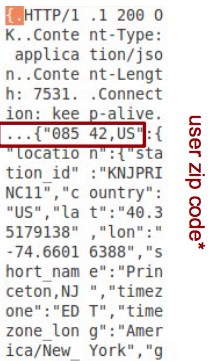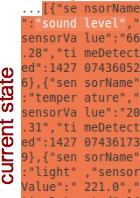Over the past several months, CITP-affiliated Ph.D. student Sarthak Grover and fellow Roya Ensafi been investigating various security and privacy vulnerabilities of Internet of Things (IoT) devices in the home network, to get a better sense of the current state of smart devices that many consumers have begun to install in their homes.
To explore this question, we purchased a collection of popular IoT devices, connected them to a laboratory network at CITP, and monitored the traffic that these devices exchanged with the public Internet. We initially expected that end-to-end encryption might foil our attempts to monitor the traffic to and from these devices. The devices we explored included a Belkin WeMo Switch, the Nest Thermostat, an Ubi Smart Speaker, a Sharx Security Camera, a PixStar Digital Photoframe, and a Smartthings hub.
What We Found: Be Afraid!
Many devices fail to encrypt at least some of the traffic that they send and receive. Investigating the traffic to and from these devices turned out to be much easier than expected, as many of the devices exchanged personal or private information with servers on the Internet in the clear, completely unencrypted.
We recently presented a summary of our findings to the Federal Trade Commission, last week at PrivacyCon. The video of Sarthak’s talk is available from the FTC website, as well as on YouTube. Among some of the more striking findings include:
- The Nest thermostat was revealing location information of the home and weather station, including the user’s zip code, in the clear. (Note: Nest promptly fixed this bug after we notified them.)
- The Ubi uses unencrypted HTTP to communicate information to its portal, including voice chats, sensor readings (sound, temperature, light, humidity). It also communicates to the user using unencrypted email. Needless to say, much of this information, including the sensor readings, could reveal critical information, such as whether the user was home, or even movements within a house.
- The Sharx security camera transmits video over unencrypted FTP; if the server for the video archive is outside of the home, this traffic could also be intercepted by an eavesdropper.
- All traffic to and from the PixStar photoframe was sent unencrypted, revealing many user interactions with the device.
 Traffic capture from Nest Thermostat in Fall 2015, showing user zip code and other information in cleartext. |
 Traffic capture from Ubi, which sends sensor values and states in clear text. |
Some devices encrypt data traffic, but encryption may not be enough. A natural reaction to some of these findings might be that these devices should encrypt all traffic that they send and receive. Indeed, some devices we investigated (e.g., the Smartthings hub) already do so. Encryption may be a good starting point, but by itself, it appears to be insufficient for preserving user privacy. For example, user interactions with these devices generate traffic signatures that reveal information, such as when power to an outlet has been switched on or off. It appears that simple traffic features such as traffic volume over time may be sufficient to reveal certain user activities.
In all cases, DNS queries from the devices clearly indicate the presence of these devices in a user’s home. Indeed, even when the data traffic itself is encrypted, other traffic sent in the clear, such as DNS lookups, may reveal not only the presence of certain devices in your home, but likely also information about both usage and activity patterns.
Of course, there is also the concern about how these companies may use and share the data that they collect, even if they manage to collect it securely. And, beyond the obvious and more conventional privacy and security risks, there are also potential physical risks to infrastructure that may result from these privacy and security problems.
Old problems, new constraints. Many of the security and privacy problems that we see with IoT devices sound familiar, but these problems arise in a new, unique context, which present unique challenges:
- Fundamentally insecure. Manufacturers of consumer products have little interest in releasing software patches and may even design the device without any interfaces for patching the software in the first place. There are various examples of insecure devices that ordinary users may connect to the network without any attempts to secure them (or any means of doing so). Occasionally, these insecure devices can result in “stepping stones” into the home for attackers to mount more extensive attacks. A recent study identified more than 500,000 insecure, publicly accessible embedded networked devices.
- Diverse. Consumer IoT settings bring a diversity of devices, manufacturers, firmware versions, and so forth. This diversity can make it difficult for a consumer (or the consumer’s ISP) to answer even simple questions such as exhaustively identifying the set of devices that are connected to the network in the first place, let alone detecting behavior or network traffic that might reveal an anomaly, compromise, or attack.
- Constrained. Many of the devices in an IoT network are severely resource-constrained: the devices may have limited processing or storage capabilities, or even limited battery life, and they often lack a screen or intuitive user interface. In some cases, a user may not even be able to log into the device.
Complicating matters, a user has limited control over the IoT device, particularly as compared to a general-purpose computing platform. When we connect a general purpose device to a network, we typically have at least a modicum of choice and control about what software we run (e.g., browser, operating system), and perhaps some more visibility or control into how that device interacts with other devices on the network and on the public Internet. When we connect a camera, thermostat, or sensor to our network, the hardware and software are much more tightly integrated, and our visibility into and control over that device is much more limited. At this point, we have trouble, for example, even knowing that a device might be sending private data to the Internet, let alone being able to stop it.
Compounding all of these problems, of course, is the access a consumer gives an untrusted IoT device to other data or devices on the home network, simply by connecting it to the network—effectively placing it behind the firewall and giving it full network access, including in many cases the shared key for the Wi-Fi network.
A Way Forward
Ultimately, multiple stakeholders may be involved with ensuring the security of a networked IoT device, including consumers, manufacturers, and Internet service providers. There remain many unanswered questions concerning both who is able to (and responsible for) securing these devices, but we should start the discussion about how to improve the security for networks with IoT devices.
This discussion will include both policy aspects (including who bears the ultimate responsibility for device insecurity, whether devices need to adopt standard practices or behavior, and for how long their manufacturers should continue to support them), as well as technical aspects (including how we design the network to better monitor and control the behavior of these often-insecure devices).
Devices should be more transparent. The first step towards improving security and privacy for IoT should be to work with manufacturers to improve the transparency of these IoT devices, so that consumers (and possibly ISPs) have more visibility into what software the devices are running, and what traffic they are sending and receiving. This, of course, is a Herculean effort, given the vast quantity and diversity of device manufacturers; an alternative would be trying to infer what devices are connected to the network based on their traffic behavior, but doing so in a way that is both comprehensive, accurate, and reasonably informative seems extremely difficult.
Instead, some IoT device manufacturers might standardize on a manifest protocol that announces basic information, such as the device type, available sensors, firmware version, the set of destinations the device expects to communicate with (and whether the traffic is encrypted), and so forth. (Of course, such a manifest poses its own security risks.)
Network infrastructure can play a role. Given such basic information, anomalous behavior that is suggestive of a compromise or data leak would be more evident to network intrusion detection systems and firewalls—in other words, we could bring more of our standard network security tools to bear on these devices, once we have a way to identify what the devices are and what their expected behavior should be. Such a manifest might also serve as a concise (and machine readable!) privacy statement; a concise manifest might be one way for consumers to evaluate their comfort with a certain device, even though it may be far from a complete privacy statement.
Armed with such basic information about the devices on the network, smart network switches would have a much easier way to implement network security policies. For example, a user could specify that the smart camera should never be able to communicate with the public Internet, or that the thermostat should only be able to interact with the window locks if someone is present.
Current network switches don’t provide easy mechanisms for consumers to either express or implement these types of policies. Advances in Software-Defined Networking (SDN) in software switches such as Open vSwitch may make it possible to implement policies that resolve contention for shared resources and conflicts, or to isolate devices on the network from one another, but even if that is a reasonable engineering direction, this technology will only take us part of the way, as users will ultimately need far better interfaces to both monitor network activity and express policies about how these devices should behave and exchange traffic.
Update [20 Jan 2015]: After significant press coverage, Nest has contacted the media to clarify that the information being leaked in cleartext was not the zip code of the thermostat, but merely the zip code that the user enters when configuring the device. (Clarifying statement here.) Of course, when would a user ever enter a zip code other than that of their home, where the thermostat was located?

IoT devices benefit from and grow value under network effect. Without an economic system of settlements the “IP stack” will remain a disorganized group of semi-connected islands. Every one for themselves.
Let’s say the IoT does indeed scale to a couple of billion endpoints. How and when are those endpoints upgraded? Who controls them and has the say-so.
Time to have a discussion over the role of settlements that serve as important price signals, incentives, and very very importantly disincentives. Even Andresseen has admitted as much in one of his bitcoin videos over the evolution of the web/internet and the role settlements might have played in the past and going forward.
I found very similar issues with an Amcrest camera; certain data was encrypted, but video was uploaded in plaintext over ftp. It turns out that Amcrest and many other consumer devices (possibly including Sharx?) outsource to a Canadian company called CloudCam, whom I contacted with my findings. They weren’t very concerned. Netgear’s Arlo kept the outgoing data encrypted, but transmitted back, in plaintext, all sorts of metadata, as well as an rtsp. I mentioned this discovery on a Netgear forum, and (perhaps by coincidence) it was fixed within two days. (Some more details, with sarcasm, at http://blog.podsnap.com/amcrest.html)
http://www8.hp.com/h20195/V2/GetPDF.aspx/4AA5-4759ENW.pdf
Yea, verily and Amen.
Is that your garage door opener sending out SPAM?
IoT indeed. Try searching for “IoS” and see what you get…
-The Urban Spaceman